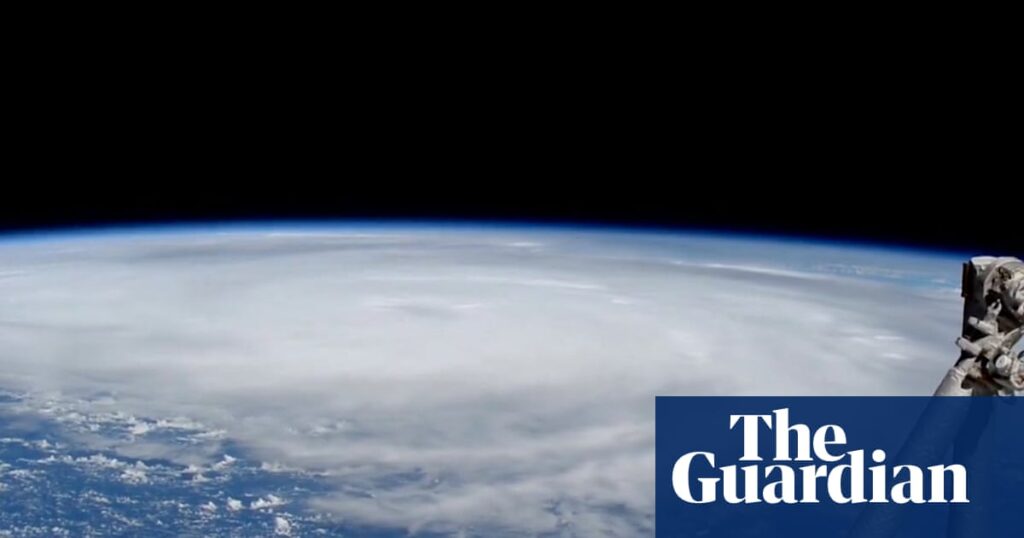Hurricane Helen made landfall on the Florida coast Thursday night as a powerful and destructive Category 4 storm, wreaking havoc across large swathes of the Gulf Coast and threatening high winds, storm surge, and heavy rain.
The Miami-based UA National Hurricane Center said late Thursday that Helen was located about 45 miles (70 kilometers) east-southeast of Tallahassee, Florida, with maximum sustained wind speeds of 225 kilometers per hour.
The superstorm has formed rapidly this week, gaining strength as it moves through the warm waters of the Gulf Coast.
Helen’s storm surge – a wall of seawater pushed onto land by hurricane-force winds – could rise as high as 20 feet (6.1 meters) in some places.
“For people who live in coastal areas and low-lying areas, this is not a survivable event,” said Jared Miller, sheriff of Wakulla County, Florida’s coast. “As time is running out, please be aware of the evacuation orders that are in effect.”
States of emergency have been declared in Florida, Georgia, the Carolinas, Virginia and Alabama.
Florida Governor Ron DeSantis warned of flooding, road closures and power outages and urged North Floridians to evacuate before time runs out. The storm is expected to weaken once it makes landfall, but it is moving quickly and could continue to grow.
“Hurricane-force winds will likely persist up to 80 miles outside the eye of the storm, and the storm will continue beyond that, especially in the Big Bend region,” DeSantis said at a news conference Thursday night. , held at the state’s Emergency Operations Center in Tallahassee.
John Daley, mayor of Florida’s capital Tallahassee, which is in Helen’s path, said the hurricane could be the strongest storm ever to hit the city. Helen could cause “unprecedented damage the likes of which we have never experienced as a community,” Daly told reporters Wednesday.
Climate scientists have warned that global warming is increasing the number and intensity of powerful hurricanes. Although individual storms are not caused by climate change, new patterns of more and more powerful hurricanes are being driven by Earth’s alarming oceans and seas. Much of Helen’s power was due to force concentrated over the Gulf of Mexico, which has reached unprecedented temperatures in recent years.
Colorado State University hurricane researcher Phil Klotzbach told The Associated Press that Helen is expected to be one of the largest storms to hit the region in years. Since 1988, only three Gulf hurricanes have exceeded Helen’s predicted size: Irma in 2017, Wilma in 2005, and Opal in 1995, he said.
Parts of Florida were already feeling the effects of the storm even before it made landfall. In areas such as Fort Myers Beach, Florida, water levels were already 2 feet above normal as of Thursday. Cities like Tampa and St. Petersburg were experiencing 5 feet of storm surge by Thursday evening.
After making landfall, the hurricane is expected to move north along the southeast coast, from Florida to North Carolina. At least 50 million people are under hurricane and tropical storm warnings.
As night falls over the North Carolina mountains, emergency officials urge residents to seek safety on higher ground as Hurricane Helen approaches land. The area has already been hit by heavy rain from another storm, and forecasters say an additional 9 to 14 inches of rain could fall as Helen’s body moves through the area Thursday night into Friday. I expected it.
“We’re seeing flooding in places we’ve never seen before in a storm like this,” said Jimmy Brissey, director of emergency services for Henderson County, south of Asheville.
Helen caused power outages in the west as it passed through the island of Cuba, affecting about 160,000 customers in the state of Artemisa and another 70,000 in the neighboring state of Pinar del Rio. According to local newspaper Guerrilla, about 800 people in the area were forced to evacuate from areas at risk of flooding due to the hurricane.
The storm pounded parts of Mexico’s Yucatan Peninsula on Wednesday, flooding roads and toppling trees as it passed offshore and brushed past the resort city of Cancun.
Helen is the eighth named storm in the Atlantic hurricane season, which began in June. The National Oceanic and Atmospheric Administration (Noaa) has predicted that this year’s Atlantic hurricane season will be above normal due to record-breaking ocean temperatures.
Reuters and The Associated Press contributed to this report



